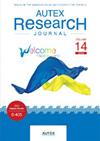克罗地亚织物金属线的鉴定
IF 1.1
4区 工程技术
Q3 MATERIALS SCIENCE, TEXTILES
引用次数: 0
摘要
摘要本文分析了17至20世纪克罗地亚历史纺织品、礼拜法衣和民间服装中的金属线编织。收集并分析了独立的窄条纹、金属丝和由金属线包裹在非金属纺织纱线上形成的srma。利用物理化学方法扫描电子显微镜结合能谱仪(SEM-EDX)对丝线中的金属成分和含量进行了分析。通过SEM-EDX方法对金属线进行截面分析,确定金属线是均匀的、镀金的还是镀银的。用光学显微镜测定了非金属纺织纱线的组成和结构。金属线主要由金、银或铜及其合金制成,但最近通常使用具有类似光泽的不太值钱的金属。srma中的非金属纺织线通常由丝绸、棉花和亚麻制成。这项研究的目的是确定克罗地亚不同地区使用的金属线的类型和成分,这可以作为修复和保护有价值的历史纺织品的数据库。此外,根据金属线的组成,可以确定生产线的技术,并可以大致确定纺织品的时间和空间年代。本文章由计算机程序翻译,如有差异,请以英文原文为准。
Identification of metal threads from Croatian fabrics
Abstract This article deals with the analysis of metal threads in weaving from historical Croatian textiles, liturgical vestments, and folk costumes from the seventeenth to the twentieth century. The independent narrow stripes, wires, and the srma that was formed by a combination of metal thread wrapped around a non-metal textile yarn were collected and analysed. Using physicochemical method scanning electron microscopy with energy-dispersive X-ray spectroscopy (SEM-EDX), the metal composition and content in the threads were analysed. By cross-sectional analysis of metal threads by the SEM-EDX method, it was determined whether the metal threads were homogeneous, gilded, or silver-plated. The composition and structure of non-metal textile yarns were determined by light microscopy. Metal threads were primarily made of gold, silver, or copper and their alloys, but recently less valuable metals having a similar shine have generally been used. Non-metal textile threads in srma are most often made of silk, cotton, and linen. The aim of this study was to determine which type and composition of metal threads were used in different regions of Croatia, which can serve as a database for the restoration and conservation of valuable historical textiles. Also, according to the composition of metal threads, the technology of production threads can be determined and the temporal and spatial dating of textile objects can be determined approximately.
求助全文
通过发布文献求助,成功后即可免费获取论文全文。
去求助
来源期刊

Autex Research Journal
MATERIALS SCIENCE, TEXTILES-
CiteScore
2.80
自引率
9.10%
发文量
40
审稿时长
>12 weeks
期刊介绍:
Only few journals deal with textile research at an international and global level complying with the highest standards.
Autex Research Journal has the aim to play a leading role in distributing scientific and technological research results on textiles publishing original and innovative papers after peer reviewing, guaranteeing quality and excellence.
Everybody dedicated to textiles and textile related materials is invited to submit papers and to contribute to a positive and appealing image of this Journal.
 求助内容:
求助内容: 应助结果提醒方式:
应助结果提醒方式:


